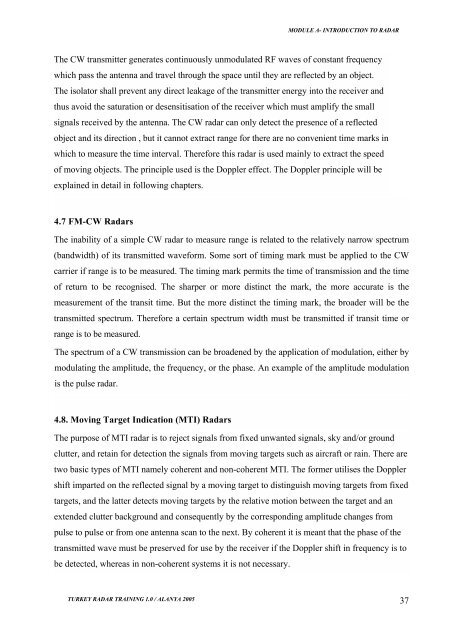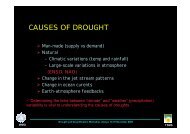training course on weather radar systems - RTC, Regional Training ...
training course on weather radar systems - RTC, Regional Training ...
training course on weather radar systems - RTC, Regional Training ...
- No tags were found...
Create successful ePaper yourself
Turn your PDF publications into a flip-book with our unique Google optimized e-Paper software.
MODULE A- INTRODUCTION TO RADAR<br />
The CW transmitter generates c<strong>on</strong>tinuously unmodulated RF waves of c<strong>on</strong>stant frequency<br />
which pass the antenna and travel through the space until they are reflected by an object.<br />
The isolator shall prevent any direct leakage of the transmitter energy into the receiver and<br />
thus avoid the saturati<strong>on</strong> or desensitisati<strong>on</strong> of the receiver which must amplify the small<br />
signals received by the antenna. The CW <strong>radar</strong> can <strong>on</strong>ly detect the presence of a reflected<br />
object and its directi<strong>on</strong> , but it cannot extract range for there are no c<strong>on</strong>venient time marks in<br />
which to measure the time interval. Therefore this <strong>radar</strong> is used mainly to extract the speed<br />
of moving objects. The principle used is the Doppler effect. The Doppler principle will be<br />
explained in detail in following chapters.<br />
4.7 FM-CW Radars<br />
The inability of a simple CW <strong>radar</strong> to measure range is related to the relatively narrow spectrum<br />
(bandwidth) of its transmitted waveform. Some sort of timing mark must be applied to the CW<br />
carrier if range is to be measured. The timing mark permits the time of transmissi<strong>on</strong> and the time<br />
of return to be recognised. The sharper or more distinct the mark, the more accurate is the<br />
measurement of the transit time. But the more distinct the timing mark, the broader will be the<br />
transmitted spectrum. Therefore a certain spectrum width must be transmitted if transit time or<br />
range is to be measured.<br />
The spectrum of a CW transmissi<strong>on</strong> can be broadened by the applicati<strong>on</strong> of modulati<strong>on</strong>, either by<br />
modulating the amplitude, the frequency, or the phase. An example of the amplitude modulati<strong>on</strong><br />
is the pulse <strong>radar</strong>.<br />
4.8. Moving Target Indicati<strong>on</strong> (MTI) Radars<br />
The purpose of MTI <strong>radar</strong> is to reject signals from fixed unwanted signals, sky and/or ground<br />
clutter, and retain for detecti<strong>on</strong> the signals from moving targets such as aircraft or rain. There are<br />
two basic types of MTI namely coherent and n<strong>on</strong>-coherent MTI. The former utilises the Doppler<br />
shift imparted <strong>on</strong> the reflected signal by a moving target to distinguish moving targets from fixed<br />
targets, and the latter detects moving targets by the relative moti<strong>on</strong> between the target and an<br />
extended clutter background and c<strong>on</strong>sequently by the corresp<strong>on</strong>ding amplitude changes from<br />
pulse to pulse or from <strong>on</strong>e antenna scan to the next. By coherent it is meant that the phase of the<br />
transmitted wave must be preserved for use by the receiver if the Doppler shift in frequency is to<br />
be detected, whereas in n<strong>on</strong>-coherent <strong>systems</strong> it is not necessary.<br />
TURKEY RADAR TRAINING 1.0 / ALANYA 2005 37
















